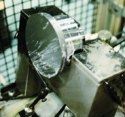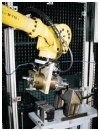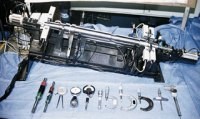Consider Closing The Loop
Looking for a way to reduce process variability, speed setup, simplify your operation? Automatic measurement and machine compensation (Closed Loop Machining) may be something to consider. Here's a shop where it's making a difference.
Share



Metalworking shops cannot operate their business in a vacuum. Each needs reliable customers to provide the work, which is a shop's life-blood. Moreover shops need suppliers to help provide technology that's appropriate for the job they're being asked to do. Thirdly, shops need resources outside itself to provide the expertise not found in-house.
A good example of a shop that has successfully identified and tapped into these critical business relationships is Helio Precision Products Inc. (Lake Bluff, Illinois). Under the leadership of its president, Howard Livingston, this 16-year-old business has grown from three employees to 177 and has maintained a torrid growth rate of 30 percent a year. "An annual growth of 30 percent per year may sound strenuous," says Mr. Livingston, "but the fact is we've done it for so long it has become our normal growth rate."
Most of Helio's growth comes from its existing customer base. They make engine and transmission parts for a variety of industries including off-road machine builders, diesel engine makers and locomotive manufacturers. The lion's share of business comes from six major customers.
"We make the investment in technology that our customers would make for themselves if they were machining the workpieces we produce for them," says Mr. Livingston. "Some of the technology is sophisticated and some is basic. The key is to apply the correct level of technology to the job. We couldn't pursue that business model with hundreds of customers. We focus on a few and make ourselves an asset to them."
Some of that applied technology involves closed loop machining, which Helio has implemented in two machining cells—one using robotic load/unloading of a turning and machining center, the second using manual loading of four machines. Here's how and why the company chose this route, and how it reaps the benefits of having applied it every day.
What's Closed Loop Machining?
The machining process is not a static environment. Mechanical relationships between the cutting tool and the work are constantly changing due to a variety of influences. These variations can be reduced but never totally eliminated.
Basically closed-loop machining is a system that can automatically compensate a machine tool for dimensional vagaries caused by worn tools, thermal growth or other process variations. A gage checks a finished workpiece, captures the dimensional data and feeds any deviations outside pre-set limits back through the CNC where the tool or axis are then offset to make up for the deviation.
In most shops, this process is manual. An operator checks a machined workpiece using various gages, charts the measurements and then manually enters the offset data into the machine's CNC. For lower lot sizes and relatively simple parts, this manual process works fine. Higher volumes and complex parts may dictate looking at automating the measurement/compensation loop to maintain throughput.
Process control is key to the success of a company such as Helio. They ship line-ready parts and assemblies to customers on a just-in-time basis so there is no margin for error. Closed loop machining practices allow for in-process adjustments to be made dynamically as parts are being machined instead of after a run.
A Tale Of Two Cells
Currently, Helio has two automatic closed loop machining cells. One cell uses a two-axis Okuma turning center and a four-axis Okuma vertical machining center, both of which are attended by a robot. The parts made in this cell are chucker-type idler shafts. At the end of each turning operation, the shafts are placed into a gage where two critical diameters are checked automatically. From the gage, the part moves to the machining center for secondary operations.
The data are stored in a Moore data collection unit, which is connected to a Letsch automatic gage. From these data, SPC charts, trend analysis and other process information can be retrieved at the cell or off-line through a data line. History from 100 parts is instantly available for view or output.
Moreover, the dimensional data gathered are also used to compensate the lathe. Tolerance bands or parameters are established based on achieving an SPC deviation of 1.33 Cpk. When each part is checked, any reading outside the preset band is automatically fed back through the machine tool CNC as a tool or axis compensation. It's a fully automatic "closed loop" system.
In Helio's other cell, a single four-axis Okuma turning center is turning a relatively complex shaft part 23 inches long. On this part, 13 critical dimensions are automatically checked at one time in the off-line gage. It too is a combination of a Moore data collection unit and a Letsch custom gage.
In this second cell, the workpieces are handled manually. The turning center and gage unit are part of a multiprocess cell that includes a gundrilling operation, ID spline cutter, cross-hole drilling station and spline rolling operation.
Pre-cut and ground bars enter the cell and are gundrilled at the first workstation. Next they are passed to a cross-drilling machine. From there they go to the shaper where an ID spline is cut. After the spline is cut, the shaft goes into the turning center and from there to the automatic gage for the inspection of 13 critical OD dimensions. Cycle time through the cell is about six minutes per shaft. A secondary operation rolls an OD spline onto to one end of the shaft.
One person operates the cell. Ergonomic cell layout puts all of the machines within a few steps of the operator who manually moves the work through the various operations. Daily volumes have moved up to around 200 parts per day.
"Originally, we had a two-axis turning center in the cell," says Mr. Livingston. "To better balance throughput and handle increased volume, we put in a dual-turret, four-axis machine to reduce the turning cycle time by half."
Increased volume and reduced machining cycle time also helped justify the use of automatic, closed loop gaging in the cell. "Before we put in the Moore data collection unit and the Letsch gage, we had two people working the cell," says Roger Dunton, production manager. "Manual part checking, using a variety of different gages, and then manually inputting offsets became a bottleneck as more work was put through the cell."
Why Do It?
There are several advantages that Helio has realized from applying closed loop machining to its turning cells especially the manually operated one. Two big advantages have been overall reduction of process variability and improved throughput.
Mr. Livingston calls it reducing the depth of process. "Eliminating places where variation can enter a process by reducing the number of steps required is one good way to gain process control," he says. "Before automating the part measurement and compensation functions, we had two operators working the cell. They used a variety of manual gages. Eventually, part production in the cell lagged because of the bottleneck created by the inspection and compensation process. Now we have one operator and one gage."
Both the shaft-producing turning cell and the robot-loaded turning/machining cell make two variations of each workpiece. While the differences are slight, there are some setup changes required to go from one part to the other.
For this changeover, Helio uses its closed-loop gaging system as a setup tool. "In the past, we had to put in a blank and tram the tools in one at a time on the lathe or machining center, run a first article, check it, re-comp any tools that were out, rerun the part, recheck, re-tram and so on," says Mr. Dunton. "It could take some time to get the new job up and running. Now the operator roughs in the tools, runs one part, puts it in the automatic gage, hits the tool comp button and all of the tools are set at once. It's been a big help for changeovers."
Closed Loop Partnering
Most of Helio's manufacturing stations are arranged in cells. Each cell is composed of duplicate CNC machines that allow the company production flexibility and redundant processing capability. "Most of our customers practice just-in-time inventory control so we need to make sure a day or week's production can get out," says Mr. Livingston.
Timing is everything and fifteen years ago, when Helio was starting out, the plan was to focus on making parts for a handful of major manufacturers more economically than they could be made in-house. "We set out to be project managers for our customers," says Mr. Livingston.
Coincidentally, over the last decade and a half, more and more, original equipment manufacturers across a wide spectrum of industries have been looking to outside suppliers to source increasing numbers of discrete parts. At the same time, many of these OEMs are trying to reduce the number of suppliers they must interface with. For companies like Helio this scenario is win-win.
"With a stable of six major customers, our growth projections are based on increasing the amount of work we do for each," says Mr. Livingston. "We look at every part we make and discuss collectively with the OEM what the part does, what it's used for, where it goes and what it's connected to. The goal here is to understand the part's functionality and by doing so, we can often reduce the cost of manufacture."
Customers are all searching for ways to get costs out of the parts they use to make products. An advantage to Helio is that once a relationship is established, the customer is receptive to suggestions that can help reduce manufacturing costs. "If they give us the job, we acquire the equipment to produce it," says Mr. Livingston. "This shop is an example of practically applied technology. We don't buy more than we need but we very much need and use what we buy."
Vendor-to-customer relations is only one of the partnerships that Helio successfully employs. The closed-loop machining cell represents another. To help get this advanced technology system up and running on the shop floor, Helio worked closely with Ellison Machinery in Warrenville, Illinois, which did the cell integration.
"Partnerships need not be complex arrangements," says Mr. Livingston. "We have expertise our customers either don't have or don't want to acquire. We, in turn, find experts who have the technical expertise we need. It works well."
Another example is heat-treating. Many of the engine and drive train components that Helio machines are wear components that require postprocess heat-treating. "We made ourselves heat treat experts to better work with our vendor," says Mr. Livingston. "Understanding the metallurgy of the heat treat process helps us accurately predict most dimensional changes that a workpiece will undergo. That knowledge, applied to our close tolerance machining capability, helped in part by closed loop feedback, lets us machine parts to a point where we rarely need to do additional post-heat treat machining."
Is It For You?
Metalworking technology is democratic in the sense that every shop has equal and unfettered access to any technology that's commercially available. A five-person business can acquire the same tools to do its job as a 500-person shop.
If technology is the science of metalworking, then its application is the art. It's the mixing and matching of technology, in effective ways, that differentiates one shop from another.
Of course, ultimately it's the applications a given shop manufactures that really call the technology tune. In addition, it's the quality of the relationships outside the shop that determine how well the tune is played.
Related Content
Addressing Manufacturing Challenges with Automation
GrayMatter Robotics’ Physical AI robotic cells for manufacturing offer immediate impact and results.
Read MoreBallbar Testing Benefits Low-Volume Manufacturing
Thanks to ballbar testing with a Renishaw QC20-W, the Autodesk Technology Centers now have more confidence in their machine tools.
Read MoreHow to Determine the Currently Active Work Offset Number
Determining the currently active work offset number is practical when the program zero point is changing between workpieces in a production run.
Read MoreThe Future of High Feed Milling in Modern Manufacturing
Achieve higher metal removal rates and enhanced predictability with ISCAR’s advanced high-feed milling tools — optimized for today’s competitive global market.
Read MoreRead Next
OEM Tour Video: Lean Manufacturing for Measurement and Metrology
How can a facility that requires manual work for some long-standing parts be made more efficient? Join us as we look inside The L. S. Starrett Company’s headquarters in Athol, Massachusetts, and see how this long-established OEM is updating its processes.
Read More















.jpg;width=860)
















